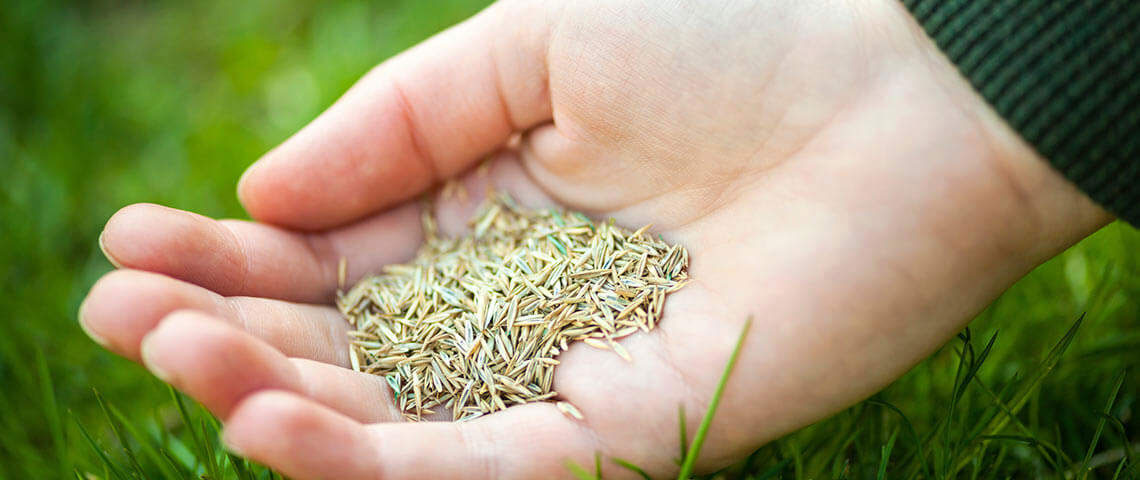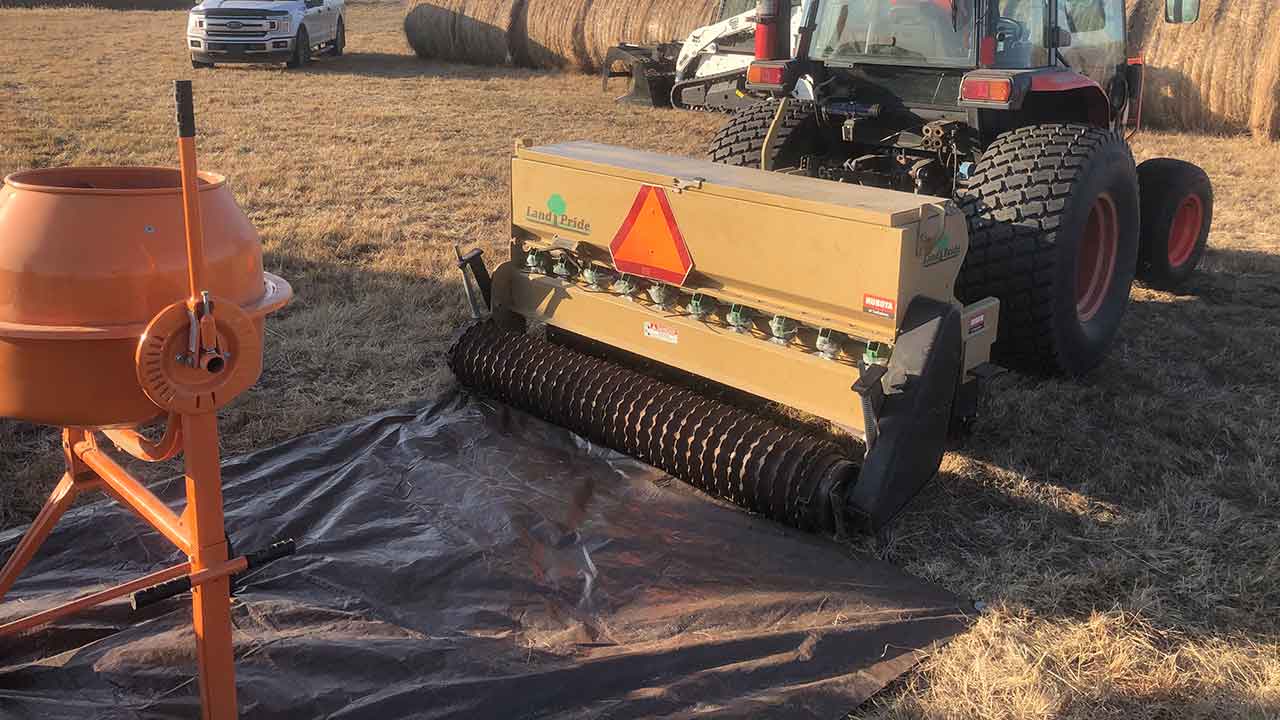The Process
Drill seeding, or Drill Press Seeding, is a mechanical grass seeding method which places seed with proper spacing, and at precisely the right depth in the soil. It is the only grass seeding method which actually places the seed in the ground. Unlike the broadcast seeding method, which often produces low-quality results, the drill seeder attachment is a ground-driven unit that seeds directly into the soil for better germination and more accurate coverage.
One of the most critical aspects in grass development is the ground preparation. A properly landscaped site must have an adequate amount of topsoil (free of lumps and rocks) which has been leveled, graded, and packed. The top 1/2 inch of soil should be raked loose in order to provide a seed bed for the newly planted grass seed. The soil preparation for sod is much the same for grass seed, and with it, a great amount of machine work and labour is required. Drill seeding can expedite this process. The topsoil, leveling, and grading should still be completed as indicated above, but much time is saved in the elimination of having to pack and then rake loose the soil. By design, the drill seeder’s front rollers crush small-to-medium size lumps and press down small stones to form a firm and well-prepared seedbed.
Seed is precisely metered with the proper spacing and at the right depth, where it will germinate quickly under the proper environmental growing conditions. Rear rollers split the shallow ridges made by the front rollers and gently form the soil around the seeds, ensuring optimum seed-to-soil contact. The result is a perfect seedbed — smooth and firm, with small stones pressed down. Additionally, the drill seeder’s operating weight of 1200-1400lbs provides superior soil compaction when compared to that of any lawn roller. Finally, the mechanical action of the drill seeder eliminates accidental broadcasting of seed onto unwanted areas such as flowerbeds and walkways. Seed only goes where the machine plants it. Drill seeding is by far the most economically productive grass planting method, at a production rate of up to one acre per hour, the seeder attachment gets the job done quickly and efficiently.

Applications
Country Yard Creations provides drill seeding service to a variety of projects, from acreages to large construction and reclamation projects. Drill seeding also provides a level of erosion control not found with standard broadcast seeding. You can choose the seed for optimal coverage and application, including standardized lawn and park grass seed, wildflowers, or any other crop that will stabilize the ground area.
Drill seed your:
- Acreages
- Farms
- Pastures
- Roadsides
- Erosion Control Project
- Sports Field
- Golf Courses
- Parks/School Yards
- Cemeteries
- Construction Restoration Sites
- Septic Fields
Maintenance
Watering
Your hydroseeding or hydromulching application contains grass seed that requires a continuous supply of warmth and moisture. This moisture must come from rainfall or watering. It is not likely that it will rain every day for the following weeks, so be sure to water frequently enough to keep moisture in the soil. A new lawn should be watered each day for the first 2 weeks, with a watering cycle of 15-60 minutes for each watering period (depending on area size and sprinkler type).
The lawn should be kept lightly damp and water should never run or puddle on the lawn. Watch the weather and adjust your watering to keep the mulch lightly damp, not soaking wet and muddy. Sitting water that has been allowed to pool from overwatering will damage grass seed. Once the first mowing is completed, watering is adjusted to 2-3 times per week, and applied heavier. Most customers will actually use much less water establishing a new hydroseeded lawn when compared to the watering requirements needed to establish sod.
Mowing
A new lawn should be mowed as soon as the grass blades are approximately 3-4 inches high. Delaying the first cutting will only encourage weed growth. Mowing properly will play a vital role in controlling weeds and encouraging the new grass to choke out these temporary weeds.
The one-third rule when mowing must be followed. With the lawn mower blades sharp, no more than 1/3 of the grass height should be cut at any one time.
Always ensure that the new grass is cut on the mower’s highest setting. Subsequent cuttings should be done often, with the grass clippings being mulched in — not bagged. The unbagged or mulched grass clippings act as compost for the new lawn.
The new grass will need an application of balanced fertilizer after the first mowing and again 30-40 days later. The development of a healthy lawn can be achieved through the use of 3 scheduled applications of a slow-release fertilizer throughout the season. Apply fertilizer on the lawn when it is dry and then water heavily and thoroughly. Apply at rates recommended on the bag, or at a rate of about 4lbs per 1000 square foot of lawn area. Do not over fertilize or under water.
Do not use weed killer on a new lawn
This is very serious. Weed control products will kill new grass in the first season. All soil contains weed seeds. The hydroseed or hydromulch slurry does not. Weeds always germinate quicker than grass, however grass will choke out weeds as it becomes established. An established lawn and a proper fertilizer program will choke out any of the remaining weeds.

The Facts about your Newly Hydroseeded Lawn
When a property has just been hydroseeded, and the growing conditions are near perfect with adequate moisture and warmth, then it is common to see accelerated grow when compared to that of regular broadcast seeding. However, when growing conditions are not favorable, with low moisture levels, extended dry spells, or seasonally low temperatures (early spring/late fall), then seed development will be affected.
If the conditions are not favorable for seed germination, the seed will wait, while protected by the hydromulch until weather conditions improve. The affect that weather has on the grass development is no different than that placed on any other plant variety. A final comment – the establishment of a lawn should take into consideration the environmental influences placed on it. What is the grass intended for? Will the new grass be used to establish a lush golf course fairway, or provide a durable play area for children in a residential back yard. Maybe the grass will soon become the play surface in a non-irrigated park, or help establish a level of erosion control in a roadway ditch or embankment. Despite what the end use will be for the grass, or what its characteristics or traits are, in the beginning, all varieties of grass seed require the same thing – warmth, moisture, and food. It cannot survive without them.
The best available method to seed a large area is to use two methods. That is first droll seed then hydromulch over top. This combination has been tested and produced the best results – especially when moisture is limited and erosion control is paramount.
